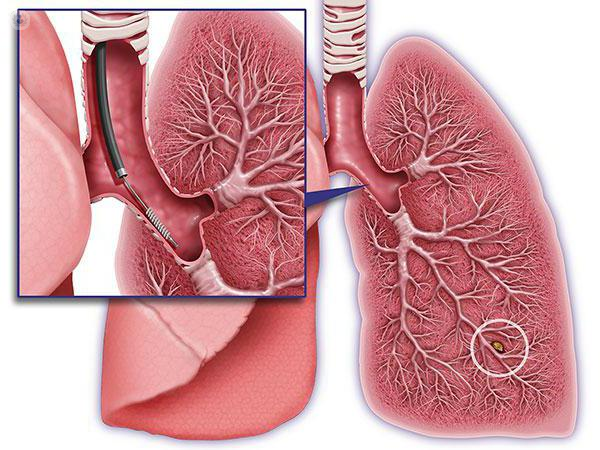

What is a bronchoscopy?
This is a medical procedure performed to visualise the airways and to detect any lung disease. It may also be carried out during treatment for certain lung problems.

What does a bronchoscopy involve?
The device used, called a bronchoscope, is a tube measuring roughly one centimetre in diameter and around 60 centimetres in length. The bronchoscope may be flexible or rigid, but the flexible type is more commonly used. The bronchoscope is inserted through the mouth or nose and is then directed down the trachea and into the lungs. This allows an examination of the upper airways. If the bronchoscope is inserted through the mouth, a larger one can be used.
Why is a bronchoscopy performed?
A bronchoscopy is performed to help diagnose lung problems. The specialist may study the airways or even take a sample for further investigation.
The following is a list of reasons for performing a bronchoscopy:
- To obtain images for studying tumours, lung tissue, or the collapse of an area of the lung.
- To examine the lymph nodes near the lungs.
- To determine why a person is coughing up blood.
- To find the causes of shortness of breath or low oxygen levels.
- To examine the airways to check for any blockages.
- To look for possible infection in the lungs and bronchi.
- To check whether there is a rejection after a lung transplant.
Preparing for a bronchoscopy:
The medical examination usually takes around 30 minutes. However, the time will ultimately depend on the specialist. Sometimes they may take a sample to perform a biopsy, or might come across complications during the procedure. Depending on the type of bronchoscopy, hospital admission may be necessary, particularly in the case of a rigid bronchoscopy. It is also recommended to go accompanied to the bronchoscopy, since sedation is used and you will need to be accompanied on the way home too. You should also avoid eating or drinking 8 to 10 hours prior to the procedure.
What do you feel during a bronchoscopy?
Initially, and until the local anaesthetic takes effect, you might feel an urge to cough or gag, due to the fluid going down your throat. You might feel pressure or a tugging sensation as the device enters the throat. You might also experience a sensation of choking or being unable to breathe. However, there is no risk of this happening, as the muscle-relaxing medications will help you feel comfortable. Finally, when the anaesthetic wears off, you might have a scratchy throat for a few days. You must not eat or drink anything immediately after the procedure.
Meaning of abnormal results:
The following pathologies can be diagnosed by performing a bronchoscopy:
- Infection caused by bacteria, viruses, fungi, parasites or tuberculosis
- Lung damage caused by allergic reactions
- Lung diseases, where the inner tissues of the lung become inflamed and damaged
- Lung cancer or cancer in the area between the lungs
- Stenosis (narrowing) of the trachea or bronchi, including severe rejection after a lung transplant.
